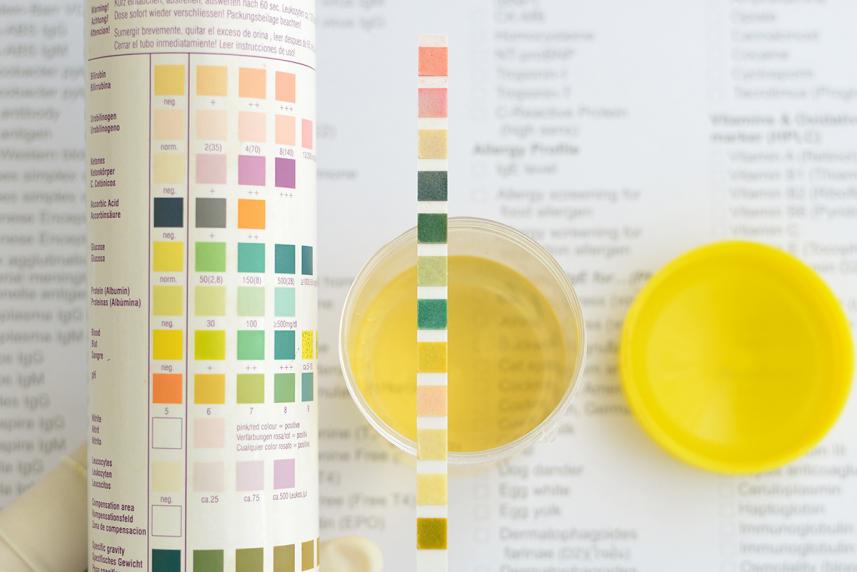2 Tests You Don’t Want to Miss if You Have Diabetes
Diabetes and chronic kidney disease often go together. Here’s why you should add these kidney tests to your list of annual checkups.

Diabetes and chronic kidney disease (CKD) are so closely connected that the United States has an organization devoted to both: the National Institute of Diabetes and Digestive and Kidney Diseases (NIDDK). According to the NIDDK, almost 1 in 3 people with diabetes also have CKD.
Chronic kidney disease is a condition in which your kidneys are so damaged, they can no longer filter your blood the way they’re supposed to. Most chronic kidney disease is caused by diabetes. That’s because the blood vessels in kidneys can be damaged if blood sugar is too high for too long, which impairs kidney function.
Faced with those facts, it’s not surprising that experts advise people who have diabetes to have their kidney health checked at least once a year. This can be done with 2 simple tests. Here’s what you need to know about these tests, plus who should put them on their annual to-do list and why.
You can get assistance with scheduling kidney checks or other diabetes-related screenings by connecting with your nurse on BlueForMe, your digital health management app. Call 844-730-2583 to see if you're eligible for BlueForMe today.
The Albumin-to-Creatinine Ratio Test
Known as an ACR, this test is done through a urine sample. It looks at 2 key compounds: a protein called albumin and a waste product called creatinine.
Albumin is made by your liver. It works to keep the right amount of fluid in your bloodstream. It’s a valuable protein, which means you wouldn’t want it thrown in the garbage. So if your kidneys are healthy, they work to stop albumin from entering your urine. But if your kidneys are damaged, they start to allow albumin and other proteins into urine. As a result, levels creep up.
Creatinine, on the other hand, is a waste byproduct of muscle repair. It needs to be shuttled out of the body. Your kidneys act as the garbage collector. They put the creatinine from your blood into your urine at a steady rate so it can get passed out of your body.
An ACR compares both compounds to see if albumin is being excreted in urine at a higher rate than normal. A normal albumin-to-creatinine ratio (ACR) is 30-300 mg/g. If albumin levels are consistently higher than the normal range when compared to creatinine, it could be a sign of kidney damage. Smaller amounts of albumin could suggest early-stage kidney disease. Higher amounts of albumin could point to more severe kidney disease.
The Glomerular Filtration Rate Test
Called a GFR for short, this blood test is another measure of how well your kidneys are working. It looks at tiny filters in the kidneys called glomeruli to see how much blood is moving through them per minute. That gives your doctor an idea of how well they are filtering out creatinine and extra fluid. A GFR also looks at your age, gender, race, and weight as part of the assessment.
Here’s how to read your GFR results:
- 60 or more: Your GFR is normal.
- Below 60: You might have kidney disease and should see a specialist called a nephrologist.
- 15 or less: This is a sign of kidney failure. At this stage, you would need dialysis or a kidney transplant.
Need help understanding your test results and next steps? Search the health library on BlueForMe, your digital health management app, for information and insights from experts. Or use the app to connect with your care team for more answers. Call 844-730-2583 to see if you're eligible for BlueForMe today.
3 Reasons to Have Your Kidneys Tested Each Year
The National Institute of Diabetes and Digestive and Kidney Diseases suggests getting these tests once a year as part of an annual checkup for anyone at risk for CKD, including:
- Adults with diabetes.
- Adults with high blood pressure.
- Anyone age 60 or older.
- Adults with a family history of kidney failure that required dialysis or a kidney transplant.
Here’s why these tests are so important.
1. Many people don’t have symptoms of kidney problems in the early stages. Getting your kidneys checked with a blood or urine test is the only way to find out for sure if you have developed chronic kidney disease. Early testing can mean early detection and early treatment to stop more kidney damage from happening.
2. Testing can show if your treatment is working. What if you’ve already been diagnosed with CKD and you’re being treated? These tests can let you know if your kidney damage has slowed down or stopped. That shows that your treatment is on track. Treatment for CKD involves treating the conditions (such as diabetes) that caused kidney damage so it doesn’t get worse.
3. Testing can help prevent kidney failure later. If left untreated, kidney disease can cause kidneys to stop functioning completely. The only way to know if the disease is progressing is to get tested as directed by the doctor. That way, your doctor will know when it’s time to adjust medications or other care if needed.
SOURCES:
[1] “What Is Chronic Kidney Disease?” National Institute of Diabetes and Digestive and Kidney Diseases, niddk.nih.gov/health-information/kidney-disease/chronic-kidney-disease-ckd/what-is-chronic-kidney-disease#:~:text=Diabetes%20is%20the%20leading%20cause,people%20with%20diabetes%20has%20CKD. Accessed July 19, 2021.
[2]. “Microalbumin Creatinine Ration.” The U.S. National Library of Medicine, MedlinePlus, medlineplus.gov/lab-tests/microalbumin-creatinine-ratio/. Accessed July 19, 2021.
[3] “ACR.” National Kidney Foundation, www.kidney.org/kidneydisease/siemens_hcp_acr. Accessed July 19, 2021.
[4] “Estimated Glomerular Filtration Rate.” National Kidney Foundation, www.kidney.org/atoz/content/gfr. Accessed July 19, 2021.
[5] “Chronic Kidney Disease Tests and Diagnosis.” National Institute of Diabetes and Digestive and Kidney Diseases, www.niddk.nih.gov/health-information/kidney-disease/chronic-kidney-disease-ckd/tests-diagnosis. Accessed July 19, 2021.
[6] “National Kidney Foundation Statement on Urine Testing Recommendations.” National Kidney Foundation, www.kidney.org/news/newsroom/StatementOnUrineTestingRecommendations. Accessed July 19, 2021.
[7] “Chronic Kidney Disease.” American Kidney Fund, www.kidneyfund.org/kidney-disease/chronic-kidney-disease-ckd/#how_is_ckd_treated. Accessed July 19, 2021.
[8] “Diabetes — A Major Risk Factor for Kidney Disease.” National Kidney Foundation, https://www.kidney.org/atoz/content/diabetes. Accessed August 9, 2021.
[9] “Albumin (Urine).” University of Rochester Medical Center, https://www.urmc.rochester.edu/encyclopedia/content.aspx?contenttypeid=167&contentid=albumin_urine. Accessed August 9, 2021.
[10] “Creatinine.” National Kidney Foundation, https://www.kidney.org/atoz/content/what-creatinine. Accessed August 9, 2021.
[11] “Microalbumin Creatinine Ration.” MedlinePlus, https://medlineplus.gov/lab-tests/microalbumin-creatinine-ratio/. Accessed August 9, 2021.
[12] “Urine Test: Microalbumin-to-Creatinine Ration.” KidsHealth, https://kidshealth.org/en/parents/test-mtc-ratio.html. Accessed August 9, 2021.
[13] “Glomerular Filtration Rate (GFR) Test.” MedlinePlus, https://medlineplus.gov/lab-tests/glomerular-filtration-rate-gfr-test/. Accessed August 9, 2021.
DISCLAIMER: Florida Blue has entered into an arrangement with Wellframe to provide members with care decision support services, information and other services. This article is provided by Linkwell Health through their arrangement with Wellframe. Please remember that all decisions that require or pertain to independent professional medical/clinical judgment or training, or the need for medical services, are solely your responsibility and the responsibility of your physicians and other healthcare providers. Wellframe is an independent company that provides online services to Florida Blue members through the Blue for Me app.



